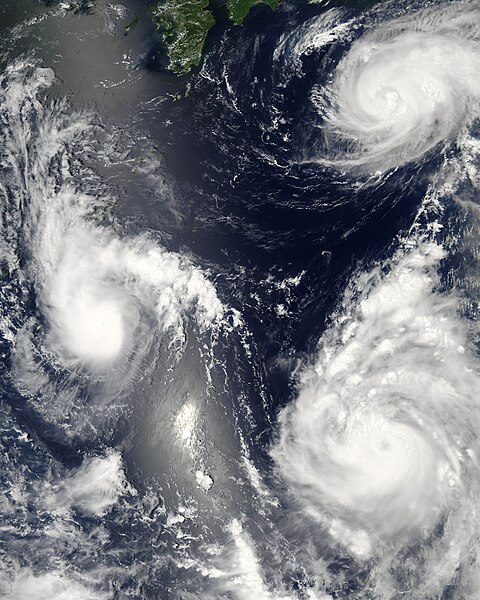Tiedosto:Maria, Bopha and Saomai 2006-08-07 0435Z.jpg
Siirry navigaatioon
Siirry hakuun

Tämän esikatselun koko: 480 × 600 kuvapistettä. Muut resoluutiot: 192 × 240 kuvapistettä | 384 × 480 kuvapistettä | 614 × 768 kuvapistettä | 819 × 1 024 kuvapistettä | 1 638 × 2 048 kuvapistettä | 7 200 × 9 000 kuvapistettä.
Alkuperäinen tiedosto (7 200 × 9 000 kuvapistettä, 7,6 MiB, MIME-tyyppi: image/jpeg)
Tiedoston historia
Päiväystä napsauttamalla näet, millainen tiedosto oli kyseisellä hetkellä.
| Päiväys | Pienoiskuva | Koko | Käyttäjä | Kommentti | |
|---|---|---|---|---|---|
| nykyinen | 8. elokuuta 2006 kello 06.06 |  | 7 200 × 9 000 (7,6 MiB) | Good kitty | == Summary == {{Information |Description=Three different typhoons were spinning over the western Pacific Ocean on August 7, 2006, when the Moderate Resolution Imaging Spectroradiometer (MODIS) on NASA’s Aqua satellite acquired this image. The strongest |
Tiedoston käyttö
Seuraava sivu käyttää tätä tiedostoa:
Tiedoston järjestelmänlaajuinen käyttö
Seuraavat muut wikit käyttävät tätä tiedostoa:
- Käyttö kohteessa ar.wikipedia.org
- Käyttö kohteessa az.wikipedia.org
- Käyttö kohteessa bg.wikipedia.org
- Käyttö kohteessa bh.wikipedia.org
- Käyttö kohteessa crh.wikipedia.org
- Käyttö kohteessa cs.wikipedia.org
- Käyttö kohteessa de.wikipedia.org
- Käyttö kohteessa en.wikipedia.org
- Typhoon
- Typhoon Saomai
- Tropical cyclone
- Wikipedia:Picture peer review/Archives/Archive2006
- User:Plasticup/MyFavorites
- Typhoon Maria (2006)
- User talk:Hurricanehink/Archive 23
- User talk:Thegreatdr/2012archive
- Wikipedia:Wikipedia Signpost/2013-11-20/Traffic report
- Wikipedia:Wikipedia Signpost/Single/2013-11-20
- Wikipedia:Top 25 Report/November 10 to 16, 2013
- User:Tfmbty/2006 Pacific typhoon season
- User:SongdaTalas/Archives of Former Articles
- Käyttö kohteessa en.wiktionary.org
- Käyttö kohteessa es.wikipedia.org
- Käyttö kohteessa hi.wikipedia.org
- Käyttö kohteessa id.wiktionary.org
- Käyttö kohteessa incubator.wikimedia.org
- Käyttö kohteessa ja.wikipedia.org
- Käyttö kohteessa ja.wikibooks.org
- Käyttö kohteessa ko.wikipedia.org
- Käyttö kohteessa lo.wikipedia.org
- Käyttö kohteessa ms.wikipedia.org
- Käyttö kohteessa my.wikipedia.org
- Käyttö kohteessa nn.wikipedia.org
- Käyttö kohteessa no.wikipedia.org
- Käyttö kohteessa pt.wikipedia.org
- Käyttö kohteessa ro.wikipedia.org
- Käyttö kohteessa ru.wikipedia.org
- Käyttö kohteessa szy.wikipedia.org
- Käyttö kohteessa th.wikipedia.org
- Käyttö kohteessa tk.wikipedia.org
- Käyttö kohteessa tr.wikipedia.org
Näytä lisää tämän tiedoston järjestelmänlaajuista käyttöä.





